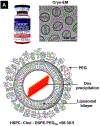Safety Considerations of Cancer Nanomedicine-A Key Step toward Translation
- PMID: 32406992
- PMCID: PMC7486239
- DOI: 10.1002/smll.202000673
Safety Considerations of Cancer Nanomedicine-A Key Step toward Translation
Abstract
The rate of translational effort of nanomedicine requires strategic planning of nanosafety research in order to enable clinical trials and safe use of nanomedicine in patients. Herein, the experiences that have emerged based on the safety data of classic liposomal formulations in the space of oncology are discussed, along with a description of the new challenges that need to be addressed according to the rapid expansion of nanomedicine platform beyond liposomes. It is valuable to consider the combined use of predictive toxicological assessment supported by deliberate investigation on aspects such as absorption, distribution, metabolism, and excretion (ADME) and toxicokinetic profiles, the risk that may be introduced during nanomanufacture, unique nanomaterials properties, and nonobvious nanosafety endpoints, for example. These efforts will allow the generation of investigational new drug-enabling safety data that can be incorporated into a rational infrastructure for regulatory decision-making. Since the safety assessment relates to nanomaterials, the investigation should cover the important physicochemical properties of the material that may lead to hazards when the nanomedicine product is utilized in humans.
Keywords: clinical trials; nano safety; safe-by-design; translational nanomedicine.
© 2020 WILEY-VCH Verlag GmbH & Co. KGaA, Weinheim.
Figures










References
-
- Chen HB; Gu ZJ; An HW; Chen CY; Chen J; Cui R; Chen SQ; Chen WHH ; Chen XS; Chen XY; Chen Z; Ding BQ; Dong Q; Fan Q; Fu T; Hou DY; Jiang Q; Ke HT; Jiang XQ; Liu G; Li SP; Li TY; Liu Z; Nie GJ; Ovais M; Pang DW; Qiu NS; Shen YQ; Tian HY; Wang C; Wang H; Wang ZQ; Xu HP; Xu JF; Yang XL; Zhu S; Zheng XC; Zhang XZ; Zhao YB; Tan WH; Zhang X; Zhao YL, Sci China Chem 2018, 61, 1503–1552.
-
- Bamrungsap S; Zhao ZL; Chen T; Wang L; Li CM; Fu T; Tan WH, Nanomedicine 2012, 7, 1253–1271. - PubMed
-
- Sun Q; Zhou Z; Qiu N; Shen Y, Adv Mater 2017, 29, 1606628. - PubMed
-
- Wang Y; Cai R; Chen C, Accounts of chemical research 2019, 52, 1507–1518. - PubMed
Publication types
MeSH terms
Substances
Grants and funding
LinkOut - more resources
Full Text Sources
Other Literature Sources
Medical

